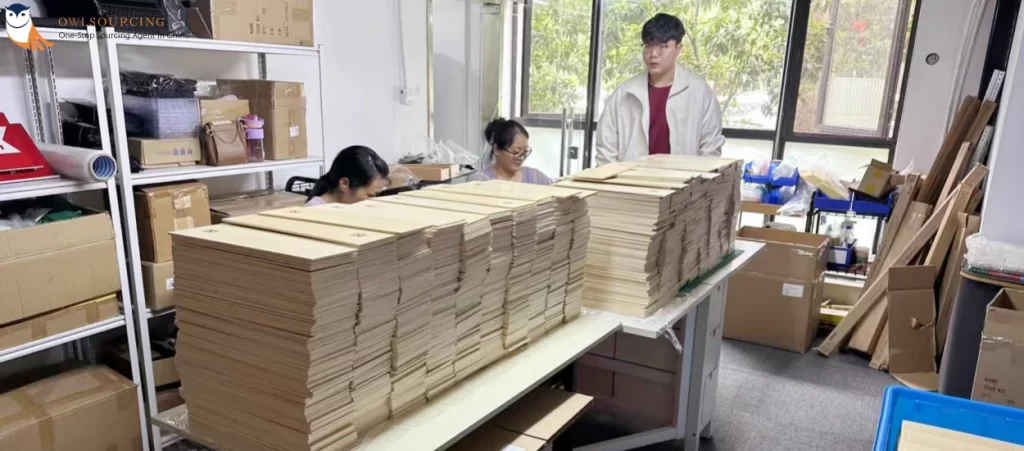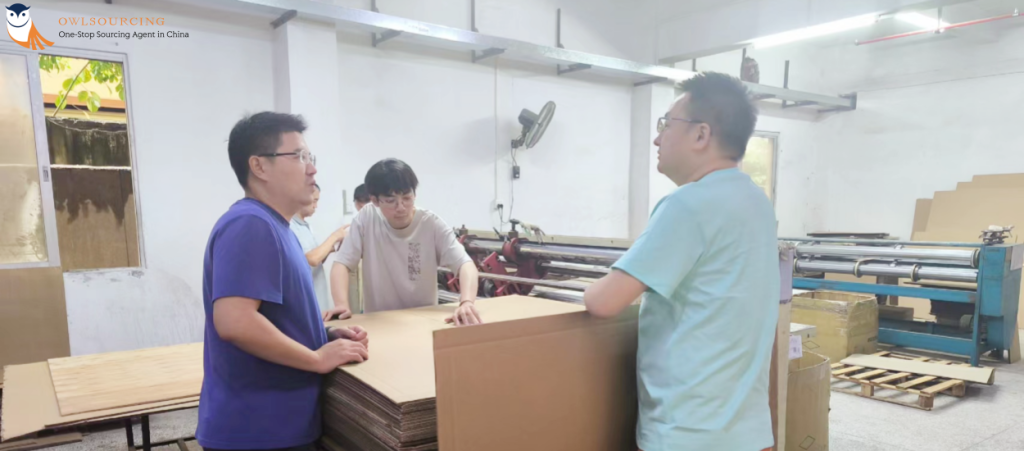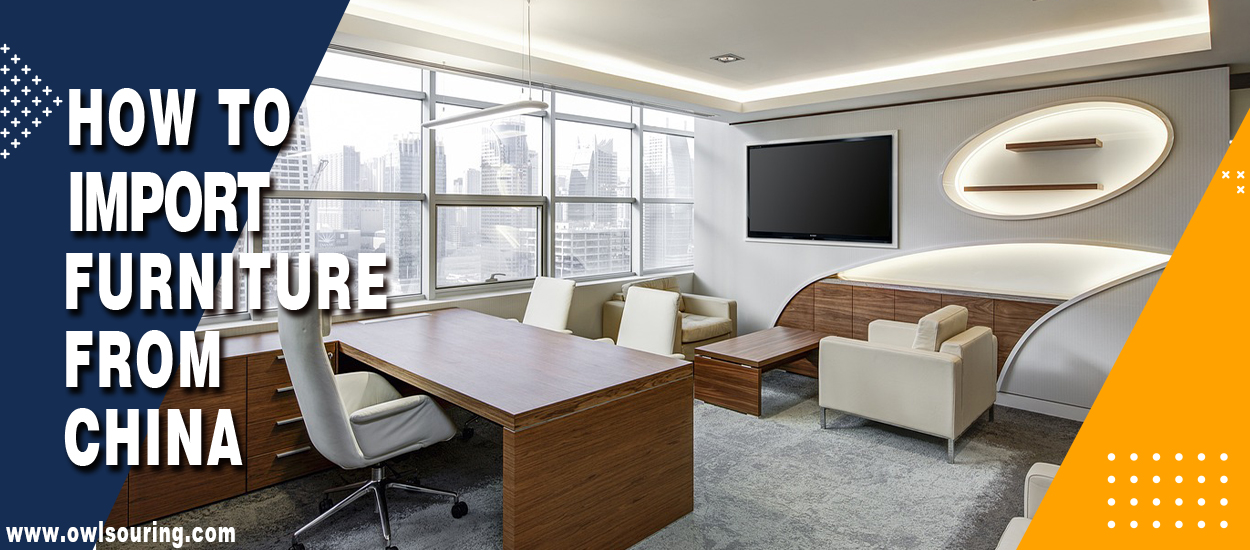China furniture imports have become a popular choice for businesses worldwide. China’s enormous production capacity and affordable pricing offer furniture businesses diverse options.
Well, importing furniture from China without experience may be daunting. However, the effort pays off in the end.
Regardless of your import experience, you must understand the Chinese furniture sector. Discover how to explore China’s furniture sector in this article. I will discuss China’s furniture market, finding reliable suppliers, and more.
Clear Summary at a Glance

| Step | Description | Key Actions |
|---|---|---|
| 1. Identify Potential Suppliers/Factories | Finding the right factory is crucial to ensure reasonable prices, good quality, and reliable lead times. Poor factory selection can lead to defects, delays, and added costs. | – Use platforms like Alibaba.com as a starting point. – Consider attending trade shows (e.g., CIFF, SPOGA) to find non-listed manufacturers. – Utilise a buying office for supplier vetting and local expertise. |
| 2. Conduct Factory Audits | Auditing ensures that suppliers meet quality, ethical, and sustainability standards. This step verifies their capabilities and reliability. | – Select at least three potential factories for evaluation. – Perform on-site audits to assess equipment, processes, and compliance. – Engage a buying office for professional factory audits. |
| 3. Request for Quotation (RFQ) | Gather formal quotes to compare prices and terms across qualified suppliers. | – Submit RFQs with detailed product specifications. – Use professional IT systems to document and manage bids. – Avoid informal or unclear quotes. |
| 4. Calculate Import Costs | Understand the full cost of importing, including shipping and local delivery, to avoid unexpected expenses. | – Request FOB (Free on Board) pricing from suppliers. – Obtain freight and handling charges from freight forwarders or buying offices. – Leverage pre-negotiated rates for cost savings. |
| 5. Negotiate Prices | Negotiate with shortlisted factories to finalise pricing based on clear specifications. | – Compare quotes from qualified suppliers. – Schedule face-to-face meetings with senior factory representatives. – Offer volume commitments for better pricing. |
| 6. Develop Samples and Conduct Quality Assurance | Verify product quality before mass production to prevent costly errors. | – Review and approve samples for all aspects (product, assembly, packaging). – Address defects during the sampling phase. – Use professional quality assurance teams for inspections. |
| 7. Ensure Compliance | Meet all legal and regulatory standards for safety, chemicals, and sustainability in your country. | – Obtain test certificates for safety standards (e.g., load, stability, tempered glass tests). – Verify chemical compliance (e.g., REACH in Europe). – Confirm sustainability certifications (e.g., FSC for wood). |
| 8. Execute Purchasing Contracts | Finalise the agreement to ensure clear terms and expectations. | – Include payment terms, specifications, quantities, tolerances, and quality standards. – Define penalties for delays or non-compliance. – Work with a buying office to draft and manage the contract. |
| 9. Shipment Arrival & Customs Clearance | Arrange customs clearance and delivery for sea freight shipments. A pre-selected freight forwarding company often handles this. | – Ensure accurate documentation, including the commercial invoice, packing list, bill of lading, and other necessary paperwork. – Pay taxes, duties, and fees such as VAT, ocean freight (if FOB), trucking, port handling, and administrative charges. – Negotiate all shipping and logistics costs upfront to avoid unexpected charges. |
| 10. Logistics Management | Leverage logistics services or furniture-buying offices to access volume discounts and manage shipments efficiently. | – Ship furniture in containers: – LCL (Less than Container Load): Cost-effective for small shipments but higher risk of damage. – FCL (Full Container Load): Preferred for bulk orders, minimising handling and potential damage. – Use 20ft, 40ft, or 40ft HQ containers. Larger containers offer better cost efficiency per cubic meter. – Container offloading is the importer’s responsibility for Full Container Loads (FCL). |
| 11. Payment Options | Secure payment terms that balance risk and cash flow. | – Common terms include: – 100% Prepayment: High risk, only for small orders (<$5,000). – 30% Deposit/70% Pre-Shipment: Moderate risk, not ideal for orders >$10,000. – 30% Deposit/70% on Bill of Lading: Standard, balances cash flow and quality control. – 0% Deposit/100% on Bill of Lading: Ideal, often secured through buying offices. – 0% Deposit/90-Day Credit: Best terms, requiring creditworthiness. |
| 12. Quality Control | Perform quality checks to avoid post-shipment risks. | – Key methods include: – Mid-production inspections – Pre-shipment inspections – Container loading checks – Daily online inspections. – A buying office’s quality team can manage customised inspection plans for new or complex orders. |
Understanding the Chinese Furniture Market

Skip this part if you already know how to import home decor from China.
In the last few decades, China’s furniture industry has grown. The sector comprises modern equipment, trained workers, and a good supply network. Chinese companies that make furniture offer a range of goods.
So they can meet the wants and needs of customers. Wood furniture accounts for 35% of the market, and metal furniture 25%. Then, 20% on cushioned furniture. The last 20% comprises plastic, bamboo, and straw.
Chinese manufacturers are very good at making many kinds of furniture. It includes simple, modern pieces and elaborate designs. China’s furniture market is flexible and dynamic. So, buyers can find goods that meet the wants of a wide range of markets.
China’s furniture production regions are strategically positioned to optimise resources and logistics. The Pearl River Delta exports 30% of China’s furniture.
Chinese furniture exports are 25% from Zhejiang’s Anji and Haining. They are known for office chairs and hardwood furniture. You can choose various solutions to meet your demands in the diverse regions.
Key Furniture Manufacturing Regions in China

| Region | Location | Specialties | Key Features |
|---|---|---|---|
| Pearl River Delta (Southern China) | Guangdong and Fujian Provinces | – Sofas (Dongguan) – Dining furniture – Flat-pack furniture (Foshan) |
Known for producing high-quality furniture and having strong expertise in export markets. |
| Yangtze River Delta (Central Coastal China) | Shanghai, Zhejiang, and Jiangsu | – Mid-to-high quality furniture – Rattan furniture – Painted solid wood furniture |
A hub for durable, aesthetically pleasing furniture with a focus on mid- to high-tier markets. |
| Western Triangle (Central China) | Fujian, Anhui, and Henan Provinces | – Cost-effective furniture – Flat-packed furniture – Outdoor furniture |
Ideal for sourcing affordable products with reliable manufacturing for export purposes. |
| Bohai Sea Region (Northern China) | Northeastern coastal regions, including Hebei and Tianjin | – Glass furniture – Metal furniture |
Specialises in innovative and modern designs, but is less developed in exporting upholstered products. |
What types of furniture can you import from China?

Chinese manufacturers make a great number of furniture pieces for each type of room in the house. This includes, but is not limited to:
- Living Room: Sofa, couch
- Bedroom: Bed, dresser, nightstand, Upholstered beds, children’s furniture
- Dining Room: Table, chair
- Outdoor Furniture: Wicker and patio sets, Rattan sets, metal furniture, parasols, and gazebos
- office chairs
When importing furniture, pay close attention to the minimum order quantity set by the supplier. Many manufacturers require high MOQs, which may be good for resellers but less so for personal-use imports.
Custom Furniture Design: Possibilities with Chinese Manufacturers
How flexible are Chinese furniture manufacturers in terms of custom designs? One of the biggest advantages of sourcing furniture from China is the wide scope for customisation.
Many manufacturers are capable of accommodating unique requests and offer flexibility in:
- Materials: Choose from wood, metal, glass, or a combination.
- Sizes: Tailor dimensions according to your needs.
- Colours and Finishes: Match aesthetic preferences or market trends.
It makes the product capable of going hand in glove with the tastes of a particular target audience. However, bear in mind that customisation affects not only pricing but also production timelines.
So, planning should be really very cautious.
Finding Reliable Furniture Suppliers in China

Finding reliable furniture suppliers in China is essential to succeed. Learn how to discover trusted Chinese furniture suppliers below:
1) Working with Sourcing Agents
If you’ve never imported from China before, sourcing agencies are beneficial. These experts can help you find and talk to good sellers because they know the regions.
They also have ties in the business world and speak different languages. Also, sourcing agents can help with quality control, price negotiations, and transportation.
2) Attending Furniture Trade Shows in China
Trade exhibitions are great for meeting vendors and seeing furniture in person. China has various trade exhibitions annually that attract thousands of consumers and producers.
CIFF is China’s largest furniture event. You can get to know suppliers better and compare goods by going to these shows.
3) Online Platforms for Sourcing Chinese Furniture

Online sourcing platforms transformed importer-supplier communication. Most consumers use Alibaba, Made-in-China, and Global Sources for their sourcing ventures.
Most importantly, be cautious and thoroughly research online suppliers. Look for suppliers with verified status, high ratings, and detailed company information.
4) Vetting Potential Suppliers
You must thoroughly vet the suppliers to ensure their legitimacy and competence. Request business licenses, export certificates, and quality control standards.
Ask for reviews from past customers and try to set up a visit to the plant. You should also get samples before you place a big order.
Quality Control Tips for Furniture Imports

Ensuring the quality of furniture imports is vital for securing your business’s image. Below are quality control tips for furniture imports:
1) Establishing Clear Product Specifications
Clear, thorough product specs are the building blocks of reasonable quality control. These should include the furniture’s size, material, colour, finish, and special shipping needs.
Give suppliers thorough technical models. If possible, provide actual samples of your desired product. Make it clear what errors are allowed in measures and colour differences.
2) Conducting Factory Audits
Factory audits are an essential way to determine what a manufacturer can do. It helps you guarantee that they can meet your quality standards.
These audits check the manufacturer’s facilities and production processes. It also checks the quality control systems and management. If you can, use a third-party auditing business for a fair evaluation.
3) Implementing Pre-Shipment Inspections
Conduct pre-shipment checks before the furniture leaves the plant. It helps to find any quality problems on time. These checks usually follow the Acceptable Quality Limit (AQL) standard.
This standard tells how many faulty units are okay in a specific sample size. A typical AQL for furniture is 2.5 for significant flaws and 4.0 for minor ones.
4) Testing Materials and Finishes
When importing furniture, it’s crucial to test the finishes and materials. Doing this ensures that they meet performance and safety standards.
Common tests include checking the amount of formaldehyde in wood furniture. It also involves checking the amount of lead in paints and coatings.
Understanding Customs and Import Regulations for Furniture

Chinese furniture imports need to navigate complex customs processes and import rules. This section covers essential customs and import regulations:
1) Tariffs and Duties

Tariffs and duties are taxes placed on imported items, like furniture. It’s essential to include these fees in your pricing plan. This is because they can significantly affect how much your goods cost.
Remembering that tariff rates can change due to economic and political factors is essential. Notably, free trade agreements and other measures reduce taxes in various countries.
2) Required Documentation for Furniture Imports
Not having or having the wrong paperwork can cause delays or extra checks. In most cases, it can even lead to the package being turned down.
A Commercial Invoice, Bill of Lading, or Product Safety Certificate may be necessary.
In some countries, you could show extra proof. For example, companies that want to get items into the European Union need an EORI.
That is the Economic Operators Registration and Identification number.
3) Compliance with Safety Standards
Ensure your imported furniture meets safety standards. It is crucial for legal compliance and consumer protection.
Furniture safety laws differ by nation and furniture type.
The US CPSC oversees furniture safety. California’s Technical Bulletin 117-2013 has many state supporters on cushioned furniture.
Generally, testing by recognised labs is needed to ensure these standards are met.
Import Regulations and Product Compliance (U.S., EU, UK)

Importing furniture requires critical compliance with the regulations in the destination country.
More specifically, here is an overview of the key considerations within the U.S., EU, and UK markets.
Importing Furniture to the U.S.
Regulatory Authorities:
Furniture imports fall under the authority of U.S. Customs and Border Protection (CBP), and the Consumer Product Safety Commission (CPSC) enforces safety standards.
Wood Furniture Regulations:
- If you’re importing wooden furniture, special rules apply to prevent illegal logging and protect against invasive pests.
- The USDA’s Animal and Plant Health Inspection Service (APHIS) mandates inspection and sanitisation (e.g., heat or chemical treatments).
- Furniture made from endangered wood species must comply with CITES (Convention on International Trade in Endangered Species).
- This includes obtaining permits and certificates indicating legal harvesting.
Anti-Dumping Duties:
Chinese bedroom furniture will face duties as high as 198.08%, based on the manufacturer and their relationship with Chinese government subsidies.
Items exempt from this include tables and mattresses that are not designed for use in the bedroom.
Cost Considerations:
Customs duties range from 0–12.8%. Additional charges include:
- Harbour Maintenance Fee (HMF): 0.125% of the shipment value.
- Merchandise Processing Fee (MPF): 0.3464% for shipments over $2,500, with a cap of $614.35.
Prohibited Regions:
Goods originating from or made in China’s Xinjiang region are banned under U.S. law.
Importing Furniture to the EU

Safety Compliance:
Furniture must comply with product safety legislation in the EU and carry the CE marking to corroborate this.
Detailed Guidance:
For a detailed overview of import regulations and tariffs, please consult the European Commission.
Importing Furniture to the UK
Regulations:
- The UK has regulations regarding furniture safety under the Furniture and Furnishings (Safety) Regulations 2018.
- Compliance includes testing for fire safety and labelling standards.
Additional Resources:
For information on import documentation and tariffs, please visit the UK government website.
| Region | Key Requirements |
|---|---|
| United Kingdom (UK) | – No import license is required. – Businesses must have a VAT number. – Small businesses or individuals need an EORI (Economic Operator Registration and Identification) number. |
| United States (USA) | – A customs bond is mandatory for importing furniture. |
| Australia | – Wooden furniture or packaging must be fumigated in China. – A fumigation certificate recognised by Australian border security is required. |
Comparison of Shipping Methods for Furniture Imports from China

Using a suitable shipping method when importing furniture from China is crucial.
Thus, you must balance cost, speed, and product safety. Below is a comparison of the standard shipping methods:
| Shipping Method | Average Transit Time | Cost | Sustainability | Pro | Cons |
| Air Freight | 3-7 days | High | Suitable for high-value or urgent shipments |
|
|
| Sea Freight (Full Container Load – FCL) | 20-45 days | Moderate to low | Ideal for large volumes of furniture |
|
|
| Sea Freight (Less than Container Load – LCL) | 20-50 days | Moderate | It suits smaller shipments that don’t fill containers | Shared container space reduces costs. |
|
| Rail Freight | 15-30 days | Moderate | Suitable for shipments to European destinations |
|
|
| Courier Services (e.g., DHL, FedEx) | 2-5 days | Very High | Best for small, high-value items or samples |
|
|
Common Challenges in Importing Furniture from China

China’s furniture imports have their challenges. This section covers common problems with importing furniture from China and solutions:
1) Language and Cultural Barriers
Language and cultural barriers are the most significant issues when buying from China. To get around this, you could hire a bilingual translator. Consider using a sourcing agent with China and Western business experience.
These experts ease communication and ensure the supplier understands your needs.
Also, understand Chinese business etiquette. Training your team to work with people from other cultures can help them communicate up to 30% better.
2) Managing Production Delays
Production delays are expected in the furniture import industry. Lack of materials or unexpected quality control issues can throw off schedules.
To deal with this problem, add extra time to your work plan to account for possible delays.
Make sure your suppliers know when things need to be delivered. You can include fines for delays in your contracts.
It’s vital to do regular follow-ups and progress checks. You can use project management tools to share changes in real time.
Importers who use these tools say that production delays decrease by 25%.
3) Dealing with Quality Inconsistencies

Importing furniture from China can be challenging due to quality concerns. Quality control in China is somewhat different. Variations in materials, quality, or finishing might result in substandard goods.
To deal with this problem, make sure the product specs are clear and complete from the start.
Provide expert drawings, materials you need, and quality standards. Also, quality checks should be conducted before and during production and before shipping.
4) Handling Shipping Damage and Returns

Due to its size and often fragile nature, furniture is more likely to get damaged during shipping. So, work closely with China suppliers to ensure that suitable packaging is used.
Many importers find that spending 5-10% more on packaging can cut damaged items by up to 50%.
Set up a clear return policy with your sellers before you place your orders.
To protect yourself against significant losses, you should buy shipping insurance. Also, carefully check the furniture when it arrives and report damages immediately.
Read More:
- How to Buy Shipping Insurance When Shipping From China
- How to Import Kitchen Cabinets from China?
- The Trends of China Manufacturing
- How to Source High-quality Pet Products from China?
Final Thoughts!
Businesses that buy furniture from China can get high-quality items at low prices. However, they need to plan their purchases and make wise decisions carefully. If you understand the Chinese furniture market, this procedure will go smoothly.
It’s vital to choose reputable suppliers and establish strong quality control measures. If done well, purchasing furniture from China may be a lucrative enterprise.
I suggest you contact our team to learn about importing furniture from China. Owlsourcing can streamline your sourcing process. We will ensure you don’t have to worry about the factors above.



2 thoughts on “How to Import Furniture from China?”
Hello, I have been experiencing difficulties with shipping my furniture from China to the US. The quotes I’ve received for shipping furniture that does not fill a 20ft container range from $6,300 to $12,400. I am currently in urgent need of assistance with shipping from China to Houston, Texas.
Thank you for your comment, Ghostda!
OwlSourcing can definitely assist you with your furniture shipping needs. We specialize in finding cost-effective shipping solutions, including consolidation services (LCL), to help lower the shipping costs for smaller loads.
Feel free to reach out to us for more details, and we’ll work with you to ensure a smoother shipping process from China to Houston.